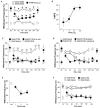Inhibition of DAGLβ as a therapeutic target for pain in sickle cell disease
- PMID: 35615929
- PMCID: PMC9973472
- DOI: 10.3324/haematol.2021.280460
Inhibition of DAGLβ as a therapeutic target for pain in sickle cell disease
Abstract
Sickle cell disease (SCD) is the most common inherited disease. Pain is a key morbidity of SCD and opioids are the main treatment but their side effects emphasize the need for new analgesic approaches. Humanized transgenic mouse models have been instructive in understanding the pathobiology of SCD and mechanisms of pain. Homozygous (HbSS) Berkley mice express >99% human sickle hemoglobin and several features of clinical SCD including hyperalgesia. Previously, we reported that the endocannabinoid 2-arachidonoylglycerol (2-AG) is a precursor of the pro-nociceptive mediator prostaglandin E2-glyceryl ester (PGE2-G) which contributes to hyperalgesia in SCD. We now demonstrate the causal role of 2-AG in hyperalgesia in sickle mice. Hyperalgesia in HbSS mice correlated with elevated levels of 2-AG in plasma, its synthesizing enzyme diacylglycerol lipase β (DAGLβ) in blood cells, and with elevated levels of PGE2 and PGE2-G, pronociceptive derivatives of 2-AG. A single intravenous injection of 2-AG produced hyperalgesia in non-hyperalgesic HbSS mice, but not in control (HbAA) mice expressing normal human HbA. JZL184, an inhibitor of 2-AG hydrolysis, also produced hyperalgesia in non-hyperalgesic HbSS or hemizygous (HbAS) mice, but did not influence hyperalgesia in hyperalgesic HbSS mice. Systemic and intraplantar administration of KT109, an inhibitor of DAGLβ, decreased mechanical and heat hyperalgesia in HbSS mice. The decrease in hyperalgesia was accompanied by reductions in 2-AG, PGE2 and PGE2-G in the blood. These results indicate that maintaining the physiological level of 2-AG in the blood by targeting DAGLβ may be a novel and effective approach to treat pain in SCD.
Figures







Comment in
-
Pain mechanisms in sickle cell disease. Are we closer to a breakthrough?Haematologica. 2023 Mar 1;108(3):663-664. doi: 10.3324/haematol.2022.281200. Haematologica. 2023. PMID: 35615934 Free PMC article. No abstract available.
References
-
- Ballas SK, Gupta K, Adams-Graves P. Sickle cell pain: a critical reappraisal. Blood. 2012;120(18):3647-3656. - PubMed
Publication types
MeSH terms
Substances
Grants and funding
LinkOut - more resources
Full Text Sources
Medical
Miscellaneous

